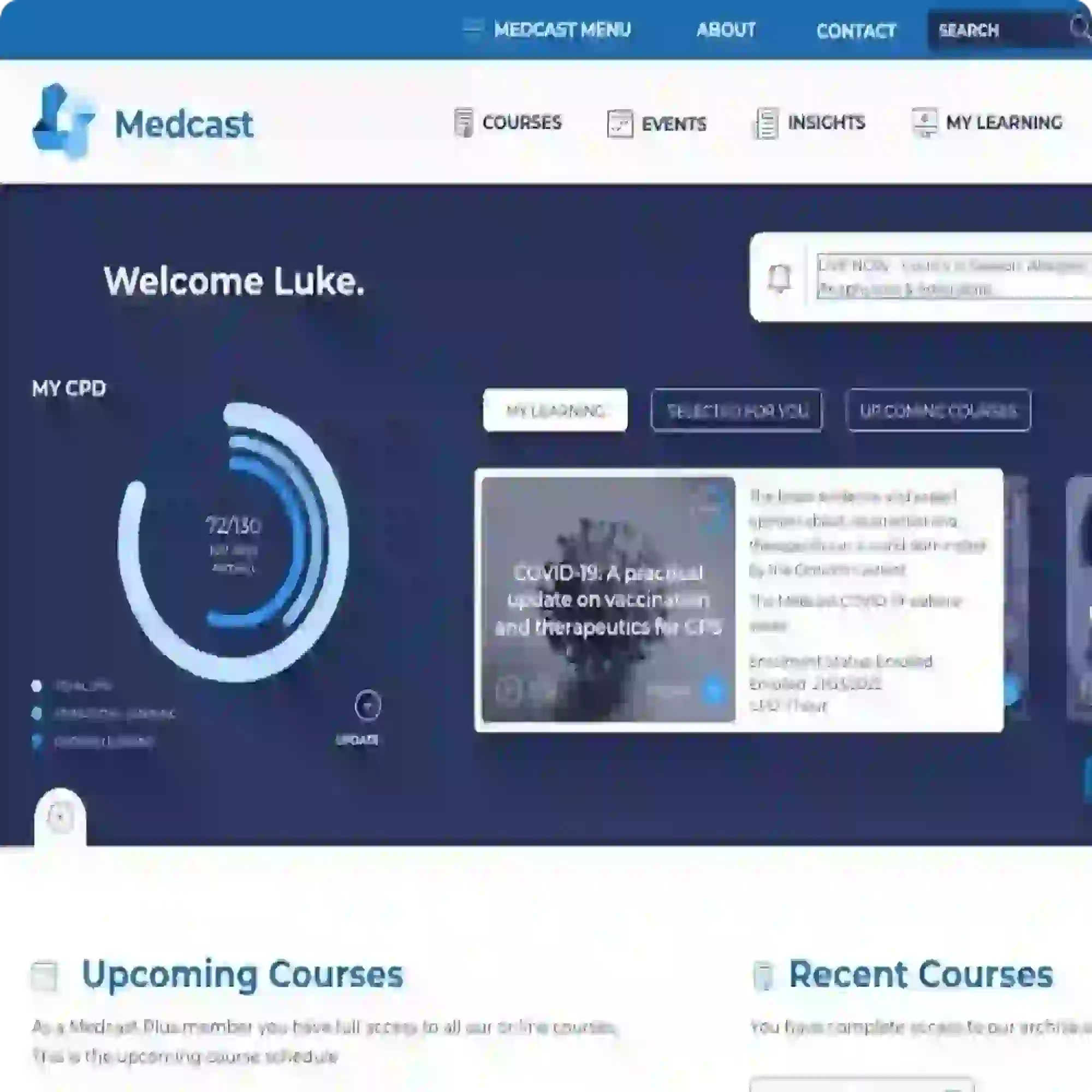Erectile dysfunction - clinical fact sheet and MCQ
![]()
Overview of erectile dysfunction
Erectile dysfunction (ED), (impotence), is defined as the persistent or recurrent inability to achieve or maintain a penile erection sufficient for satisfactory sexual activity. Other manifestations of sexual dysfunction, such as low libido or premature ejaculation, are common associations.1,2,3
About 30% of the male population have ED, increasing to over 60% in men aged 70 years and older.2
Assessment of erectile dysfunction
A comprehensive physical, sexual, and psychosocial history and health evaluation is essential, as ED often coexists with other conditions such as diabetes and cardiovascular disease.1,2,3 About half of men with confirmed coronary artery disease have ED, while in others, ED is an early marker of cardiovascular disease, preceding coronary symptoms by up to five years.3 In younger patients, ED is an independent risk factor for future atherosclerotic events. ED also is often associated with symptomatic benign prostatic hyperplasia (BPH).1
Consider screening for ED as part of routine consultations for male patients.
Risk factors for erectile dysfunction include:1,3,4
-
older age
-
cardiovascular disease and associated risk factors (eg, sedentary lifestyle, diabetes, hypertension, dyslipidaemia, obstructive sleep apnoea, smoking)
-
diabetes and other endocrine conditions (eg, androgen deficiency, hypogonadism, and thyroid disease)
-
certain medications (eg, antihypertensives, psychotropic medications, antiandrogens)
-
radical prostatectomy or radiation therapy for prostate cancer
-
penile disorders eg, Peyronie disease, venous leak (venogenic erectile dysfunction or penile venous insufficiency)
-
prostate conditions including BPH
-
substance use, including alcohol and recreational drugs (eg, amphetamines and barbiturates)
-
psychological factors (eg, history of sexual abuse, depression, stress and anxiety)
-
neurological disorders of the autonomic nervous system, brain, and spinal cord
-
obesity
Clinical evaluation involves:
-
medical history:2
-
medication review
-
common comorbidities such as diagnosed diabetes or cardiovascular disease
-
general health, including history of pelvic surgery/radiation or genital disease
-
lifestyle, including smoking, drug use, and alcohol consumption
-
mental health evaluation, such as presence of depression/anxiety, partner-related issues, and history of sexual abuse
-
physical examination:2,3
-
erectile dysfunction may be a marker for asymptomatic cardiovascular disease so cardiovascular risk assessment is indicated (blood pressure, heart rate, body mass index, carotid bruits, waist circumference, cardiac assessment)
-
examination of penis and testes
-
neurological assessment, such as for peripheral neuropathy
-
further tests should be guided by history and clinical exam, and may include:3
-
full blood count
-
kidney and liver function tests
-
thyroid stimulating hormone (to screen for thyroid disorders)
-
fasting blood glucose (to screen for diabetes)
-
lipid profile (to screen for dyslipidaemia)
-
morning testosterone assay (to screen for hypogonadism)
-
cardiovascular workup if indicated
Approximately 20% have a psychogenic aetiology (particularly in those new to sexual activity). Referral for psychosexual or relationship counselling may be indicated in these situations.1
Management of erectile dysfunction
First-line treatment involves addressing modifiable lifestyle and risk factors, including optimising management of comorbid conditions such as diabetes, hypertension, or dyslipidaemia.
ED from organic causes commonly leads to psychological responses, which may confound diagnosis and management. Comprehensive management should involve both partners and include counselling and realistic treatment goals.3
1. Exercise tolerance should be evaluated for all patients with ED
To help inform advice regarding sexual exertion.1 High risk of death or significant morbidity from sexual exertion is considered with:1,5
-
unstable or refractory angina
-
poorly controlled hypertension
-
congestive heart failure
-
myocardial infarction within the last fortnight without intervention
-
exercise-induced ventricular tachycardia
-
poorly controlled atrial fibrillation
-
symptomatic hypertrophic obstructive cardiomyopathy
-
moderate to severe aortic stenosis
Patients with ED in this category should be advised against sexual intercourse until a formal cardiology assessment has been completed.1
2. Pharmacological treatment:
-
oral phosphodiesterase type 5 (PDE5) inhibitors (eg, avanafil, sildenafil, tadalafil, vardenafil) are first-line pharmacological therapy unless contraindicated (eg, concurrent nitrate therapy due to risk of severe hypotension)1
-
choice of initial drug can be based on patient preference1 - see comparison table below
-
dosages are tailored based on response and adverse effects1
-
higher doses may be required in the presence of vascular disease or neuropathy1
-
adverse effects (eg, headache, dizziness, facial flushing, dyspepsia, dizziness) are dose-dependent1
-
take caution in the presence of kidney or liver impairment1
-
trial at least two different oral PDE5 inhibitors at full dose seven to eight times before deciding to escalate therapy3
-
note that sexual stimulation is still required to achieve an erection1
Image credit: Jannini E, Droupy S. Needs and Expectations of Patients with Erectile Dysfunction: An Update on Pharmacological Innovations in Phosphodiesterase Type 5 Inhibition with Focus on Sildenafil. Sex Med. 2019;7:1-10
-
intracavernosal vasodilator injections are second-line treatment if oral PDE5 inhibitor therapy fails or is contraindicated1
-
alprostadil is preferred for monotherapy; if this is unsuccessful despite maximum dose, consider referral
-
papaverine and phentolamine have a higher risk of priapism (abnormally sustained erection with risk of permanent tissue damage)
-
patient must be properly trained to self-administer injections and given clear instructions on priapism management
3. Non-pharmacological treatments:
-
considered if pharmacological interventions are ineffective or contraindicated2
-
vacuum erection devices are safe, relatively inexpensive,1,3 and may be preferable to intracavernosal injections1
-
semirigid or inflatable penile implants by a urologist are effective but also expensive and preclude future natural erections1
4. Testosterone therapy for erectile dysfunction:
-
reserved for confirmed hypogonadism and androgen deficiency if PDE5 inhibitor therapy fails3
-
is more effective at treating low libido than ED3
-
may improve erectile function modestly though monotherapy with testosterone supplements is not considered effective3
-
unclear benefit in androgen-deficient males already on PDE5 inhibitors1
References
-
Therapeutic Guidelines. Erectile dysfunction. 2023. (last viewed February 2025).
-
Healthy Male. Erectile dysfunction. 2024. (last viewed February 2025).
-
Lowy M, Ramanathan V. Erectile dysfunction: causes, assessment and management options. Aust Prescr. 2022;45:159-61.
-
Nehra A, Jackson G, Miner M, et al. The Princeton III Consensus recommendations for the management of erectile dysfunction and cardiovascular disease. Mayo Clin Proc. 2012;87(8):766-78.
Claim your CPD
After reading the clinical summary above and reviewing the references, complete the quiz to gain 30 minutes of EA CPD and 30 minutes of RP CPD.
You can either self-report CPD to your CPD home, or Medcast will track your learning via your personal CPD Tracker and you can download and report these points once a year. See our CPD Tracker FAQ.
Quiz
Please log in or sign up for a free Medcast account to access the case study questions and achieve the CPD credits.
The Medcast medical education team is a group of highly experienced, practicing GPs, health professionals and medical writers.
Become a member and get unlimited access to 100s of hours of premium education.
Learn moreCo-billing and split billing are often a source of confusion for many GPs. This FastTrack clearly defines these two methods of billing, including examples, explanations of when it is and isn’t appropriate to co- or split bill, and common compliance pitfalls. 30 mins each RP and EA available with the quiz.
The Coordinated Veterans’ Care (CVC) Program is a DVA initiative that allows GPs to provide structured, proactive care in the community for eligible veterans and war widows. This FastTrack provides a guide to billing the CVC program, and outlines a strategy for its practice-wide integration.
Achilles tendinopathy is a common cause of posterior heel pain and functional impairment. GPs are well-placed to coordinate care for these patients. This FastTrack fact sheet provides a concise summary of diagnosis and non-surgical management, including when to refer. Earn 30mins each RP and EA CPD with the quiz.

